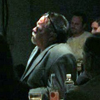New-music champion Bonnie Wright closed out her Fresh Sound fall concert series with a bang: A sprawling double-bill affair at the funky-chic-industrial Bread & Salt featured fearless UK improviser Tim Hodgkinson and Nortec Collective founder Ramón Amezcua. The two engaged in a concert that dealt serious challenges to the long-held assumptions of what distinguishes music from sound and whether a lack of harmony, melody or pre-conceived structures separate sound from noise -- and whether any of those questions even matter.
Tim Hodgkinson
Hodgkinson makes his living these days as a "lap-steel and electronics" performer. Anyone hoping to catch a few Junior Brown or Vangelis licks would have left disappointed, though, because Hodgkinson's art doesn't involve manipulating the lap-steel or the electronics in any recognizable fashion.
He began by scraping the windings of excess string ends and tapping on the highly amplified body of the instrument for spastic, non-metric beats, then continued to assault the instrument with small metal and wood rods, a hair-comb, a tiny violin bow and, in true performance-art audacity, the beard on his chin. It was all about sound and the wicked, random sorcery that can be divined by using an instrument as a sound-generator.
There were no concessions made to melody, harmony or rhythm, yet the absence of the three pillars of music did not seem unmusical. Hodgkinson's set was full of adventure, audacity and hilarity.
Ramón Amezcua
Whereas the first set was devoid of anything approaching a regular beat, the second set by Amezcua was nothing but beat, begging the question, "What happens when you strip away every melodic element from rap music?" And I found that the answer comes in multiple implications that force the listener to engage their own brain to sort through.
SoundDiego
Music. Community. Culture.
Using three "vintage" analog drum-machines (Roland TR 808, TB 303 and Drumatix) with other electronic accessories, Amezcua conjured up a landscape dominated by an earth-shattering bass drum on "1" and "3," guiding a symphony of percussive accents on "2" and "4" -- all pumped to maximum volume through a sound system that sent those beats swirling around the rustic space.
Most interesting to me was when he would layer and juxtapose clashing tempi that threatened to permanently scramble the neurons, then synch them back together by slamming his fist down on a big red button that reminded me of what you hit when you think you know the answer to a question on "Jeopardy."
Hodgkinson and Amezcua Duet
When Hodgkinson and Amezcua joined forces for a duet, the spontaneous pairing had all the potential in the world, since it paired two innovators from opposite ends of the sound/noise beat/no beat spectrum. It had the additional allure of featuring Hodgkinson playing clarinet, an instrument he has obviously mastered in a semi-traditional sense. But duets, especially free-improvisation duets, depend almost entirely on give and take, and this one was lopsided from the get go.
Let me say this: It was glorious to hear Hodgkinson strangle and caress the ebony horn with drunken vibrato and chirping multiphonics over a drop-dead relentless beat, but in the end, the relentless beat would win every time. It would have been breathtaking to see and hear Amezcua engage in the ebb and flow, vary the dynamics and occasionally start from scratch -- but that never happened. What did happen was a contest as old as the John Henry versus the machine myth, and by the time Amezcua discovered that the volume and density of his construct could also be attenuated, much of the potential had been drained from the encounter.
But make no mistake -- this was still a fascinating experiment that challenged, defied and ridiculed our expectations, very much in the spirit of Bonnie Wright's aesthetic, and it illustrated how important these discussions and debates are. No one else in San Diego has done more to facilitate this conversation than Ms. Wright, making the chasm between this concert and the next one in January of 2015, when her series resumes, seem monstrous, indeed.

Robert Bush is a freelance jazz writer who has been exploring the San Diego improvised music scene for more than 30 years.




